With inspiration from America, the Danish city of Vejle is testing a new type of stormwater infiltration bed which purifies and filtrates contaminated road water. A specially designed topsoil removes the pollutants from the road water as it seeps through the soil.
When it rains, heavy metals and other pollutants are led away
from roads with stormwater runoff. The stormwater takes along with
it substances like brake and tire dust, as well as particles from
the exhaust of cars and from the road surface itself.
On several occasions, Vejle Municipality has been in a situation
in which the city's combined sewer systems were so overloaded that
it led to the overflow of sewage into Vejle Fjord in connection
with rainfall. In 2011, such an event meant that the adjacent beach
lost its Blue flag; a mark of excellent bathing water quality,
because untreated wastewater had ended up in the fjord.
Separate sewer systems and infiltration
To improve the fjord's bathing water quality in the future, Vejle
Municipality, the city utility company and a number of
collaboration partners, are currently testing suitable solutions
for managing stormwater in a pilot area.
"We are looking at using either separate sewer systems or local
management of rainwater in the selected pilot area. Both of these
solutions are considerably less expensive than the current combined
sewer system. We avoid having to establish subsurface basins as
well as pumping stations and pressure piping, and we avoid having
to pump large quantities of stormwater into the treatment plant,
which would have a considerable environmental impact," said Peter
Duus from Orbicon, one of the collaboration partners in the
project.
Gitte Bisgaard from Vejle Spildevand, the city's utility company,
also believes there are benefits to be gained from decoupling the
stormwater from the combined system.
"We believe that managing rainwater locally is an interesting
idea, because it means we won't have to dig up the roads. The
rainwater can be collected and utilised locally on the individual
property or it can infiltrate into the ground - and citizens can
receive funding for such projects. We have decided to launch a
pilot project for public roads. But if the citizens prefer separate
sewer systems, that will be the final solution, " she said.

Topsoil serves to filter the road water
It was decided to develop and test two roadside infiltration beds
to manage the road water. These infiltration beds are the first of
their kind in Denmark. The infiltration beds were located where
there used to be chicanes. The beds were constructed using topsoil
which is a mixture of chalk, sand and compost. The soil is expected
to be able to retain phosphorus, heavy metals and other substances
before the water seeps down in to the groundwater. Additionally, as
a test, plants have been planted to see whether they can endure the
changeable conditions in the beds.
In the lower part of the infiltration bed, an infiltration well
has been established which comes into function about five times a
year when the infiltration bed is full. Stormwater runs down into
the six-meter deep infiltration well and is allowed to drain.
Annually, about 95% of precipitation runs through the topsoil and
about 5% will run into the infiltration well. The infiltration well
was chosen rather than dry wells, because it can be installed in a
small area through drilling, without major excavation work.
The unit is dimensioned for a five-year occurrence. This means
that every five years, water from the infiltration bed will
overflow to the road. This corresponds to what would normally
dimension a new stormwater sewer.
Below the beds, a horizontal drain pipe has been laid which
collects some of the water which has been through the topsoil. It
is possible to take samples, and accordingly, together with Aalborg
University, which is another one of the project's collaboration
partners, Vejle Spildevand can regularly measure the hydraulic
capacity and treatment capability of the beds.

Inspiration from the USA
The inspiration for infiltration beds is from the USA where beds
are primarily used in Portland and Seattle.
"Here infiltration beds are established by the hundreds as a
central part of decoupling road water. If there is more room, it
may be appropriate to create stormwater beds in verges and green
areas, but in many places there is only room in the roadway itself.
In this case, infiltration beds may be a fine solution which help
both reduce speed and become a green element in the asphalt", said
Peter Duus and continued:
"We have tested the new unit which percolated what corresponds to
a 20-year rain without overflow to the infiltration well. This
exceeds the dimensions of the sewer, but in time, a clogging lag
will form in the topsoil which lowers the capacity. Measurements
after six months' operations are still very positive relative to
our design criteria".
Large savings in time
To be on the safe side, infiltration beds have been created on a
road without drinking water interests, but if the unit works as
intended, it should be used everywhere.
"If we were to establish two similar infiltration beds again, we
would estimate total operating expenses of about DKK 400,000. We
expect rather significant savings in connection with large
contracts and further product and methods development", said Peter
Duus.
The annual operating costs are currently unknown but estimated at
around DKK 5,000 per year for operational activities.